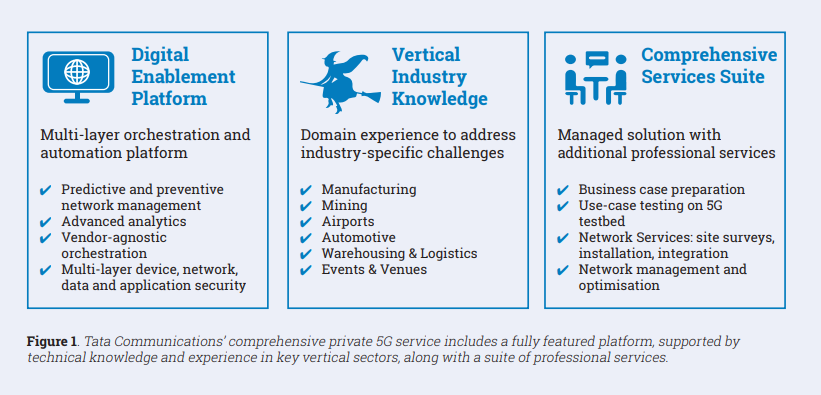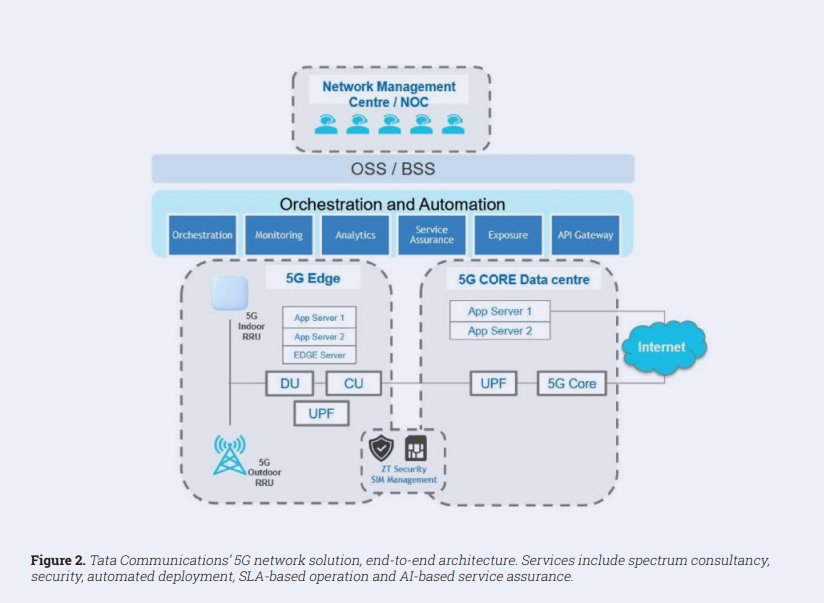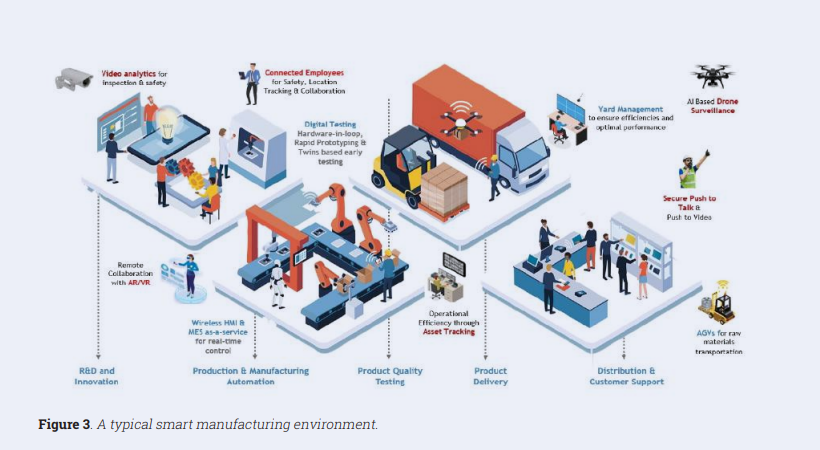Private 5G networks are a means to an end, that end being the conversion of massive amounts of IoT data into actionable local and distributed information and intelligence that is securely accessible for authorised personnel and third parties in corporate ecosystems. Private 5G networks are part of the broader organisational trend towards digital transformation. The term digital transformation refers to the deep integration of digital enabled processes into all aspects of an enterprise, along with an associated cultural change. The key objective is to enhance customer experiences by implementing fundamental operational changes. Private 5G, with its combination of greater device density, high bandwidth and low latency services enables transformative connectivity, which in turn allows enterprises to realise their transformation strategy, write Bob Emmerson and Robin Duke-Woolley, Beecham Research.
Private 5G is a catalyst to elevate industrial operations. The main benefits of private cellular networks for business operations include:
- Consistent localised campus coverage, both indoors and outdoors, designed to meet on-site needs
- A highly secure environment, with enhanced network security and data remaining on-site
- The provision of enough network capacity to meet connectivity and data handling requirements at all times
- Local management control over network traffic and use, including seamless integration with enterprise IT/OT
- Very high and controllable network reliability
- Predictable and assured low latency – data control
- High data throughput and support for high density devices
The infrastructure is a software-defined network that significantly raises the performance and capacity bar. Within the 5G framework, massive machine type communications (mMTC) can support up to one million devices per square kilometre; enhanced mobile broadband (eMBB) can transmit data at 10 gigabits per second; and ultra-reliable low latency communications (URLLC) offers extremely low, down to 1ms latency. These services are set to drive the expansion of a massive hyperconnected ecosystem where networks serve the connectivity requirements of billions of battery-lowered, low power consumption devices, with acceptable performance trade-offs between speed, latency, and cost.
Private 5G is essentially a wireless LAN that delivers unified connectivity and a secure means of wireless communication within a specific area. It functions as a wireless extension of an enterprise’s wireline LAN.
Survey results
An international survey of 750 senior executives in key business sectors and across leading countries in APAC, Europe and North America was recently conducted by Tata Communications into what the company calls ‘the digital-first advantage’. Among other findings, this underlined the importance of having a transformation strategy, supporting a workforce that needs to be able to work anytime and anywhere. In addition, there is a clear need to establish better channels of communication and collaboration with a wide ecosystem. To emphasise that, 41% of survey respondents said that without a shift to digital-first during the pandemic, they would have lost significant market share.
Companies should not neglect their people and culture. They need to invest in the workforce, or risk wasting their digital technology investments. One-third of respondents to the survey said that a lack of digital skills was a major issue. People and skills are just as important to consider as technology. They need to use technology in a way that enhances employee welfare and engagement. 45% of companies in the survey said that without the right tools and systems to support new ways of working, they risked employee burnout in the longer term.

A comprehensive proposition
Supporting this move towards private 5G in the market, Tata Communications’ MOVE private network proposition is designed to help enterprises enable that digital transformation journey. It is a fully managed service encompassing site survey through to network deployment and management. As shown in Figure 1, it is a one stop offer, comprising pre-integrated private network, data analytics, and a network management platform, that can be curated to individual digitisation and connectivity requirements. The services suite includes a 5G testbed that can be used to test use cases before they are deployed.
The architecture includes an orchestration and automation platform overlay to the 5G edge and 5G data centre components. A key feature is the ability to deploy private networks across multiple sites and administer them from a central location. This is realised by connecting them over Tata Communications’ extensive global network infrastructure.
Platform access is via a self-service portal, providing control and visibility over the connectivity, devices and edge applications. Multi-layer security is another key feature. Tata Communications also provides domain experience and an understanding of industry specific challenges and needs.
In summary, the functionality of the Tata Communications’ MOVE private network proposition includes:
- Rich partnership ecosystem to provide industry-specific use cases
- Business consultation, to estimate business impact of the selected use cases
- Customer experience / customer excellence centre for demos or trials
- End-to-end integration with strong data analytics and edge compute
- Zero-trust security, to protect from any internal or external threats
- Support for hybrid use cases and total cost of ownership (TCO) optimisation
- Orchestration and automation capabilities, with which to manage legacy technologies as well as private 5G
Edge compute
Picking up on the 5G edge component identified above, edge compute provides real-time business intelligence on operations in the local environment, as they occur. Both developments keep information on-premises, thereby improving security. By transferring a significant percentage of the processing tasks from the cloud to individual local servers, edge compute helps reduce network congestion and enhances the quality of experience for end users. Edge compute is a relatively recent development. It reflects the scale of IoT traffic, which will grow in line with device deployments, as well as the move to more real time processing. Forecasts indicate that IoT device deployments are set to grow at an annual rate of nearly 12% through the decade to 2030, leading to 29 billion connected devices by the end of the decade (Source: Statista). To put this into sharper context, by 2030 there are expected to be more IoT devices connected to mobile networks than mobile handsets.
As IoT generates increasing amounts of data, it has become unwieldy and too slow to send all that data to the cloud for processing then send it back for local control. Instead, it needs to be aggregated and processed close to source in smaller volumes. This challenge has been anticipated and addressed by edge compute, which processes the data at or close to the source, the edge of the network. This results in more efficient data processing. Advances in chipset technology have increased the computing resources of devices and the compact hardware products deployed at the edge, enabling them to function as small nodes in large intelligent networks.

As indicated earlier in Figure 1, the architecture of Tata Communications’ solution includes an orchestration and automation platform overlay to the 5G edge and 5G data centre shown in Figure 2. The digital enablement platform provides automated configuration and provisioning, accessing agnostic network management, closed loop automation and zero-trust security.
Leading sectors for private 5G
Tata Communications private 5G offer is particularly focused on smart manufacturing, warehousing and logistics, extractive industries (mining and raw materials), sporting and entertainment venues, seaports and airports. Each of these sectors is currently experiencing strong take up in use of private 5G, especially where there is an international element to operations. For example, recent world events such as the COVID-19 pandemic and war in Ukraine have had a substantial impact on manufacturing, warehousing and logistics, as well as airports and seaports. These sectors are experiencing a rapidly increasing need for higher levels of automation on site as well as across sites internationally.

A typical use case is shown in Figure 3. This illustrates the versatile functionality of a private 5G deployment in manufacturing and distribution operations. Note the digital testing facility, which includes rapid prototyping and management of digital twins, based on early testing.
There are five mainstream functions in this manufacturing environment: R&D and innovation; production and manufacturing automation; product quality testing; product delivery; and distribution and customer support. They reflect the flow from design concept through to delivery to the customers. In addition, this value chain involves ten IoT applications, with video analytics on the left and AI based drone surveillance on the right. A private 5G network can be used to facilitate communications and collaboration between the sectors and deliver both real-time and historic data to IT and C-level management.
In just a decade, IoT has moved from a support role in business operations to becoming increasingly central as the need to process more data, with higher levels of automation has grown. This is impacting on many sectors, but in particular those involving:
- Manufacturing
- Warehousing and logistics
- Extractive industries
- Sporting and entertainment venues
- Seaports and airports
This has raised the need for private networking both for on-site operations and across sites, in particular for international operations.
In response to this, Tata Communications’ MOVE private network proposition offers the main benefits of private networking for enterprises. It is a comprehensive solution, a proposition that provides an end-to-end, cutting-edge, digital transformation solution.
The key benefits for enterprises that deploy a Tata Communications MOVE network include:
- Improved profitability through ROI consultation and implementing actionable business insights generated by data analytics
- Ease of testing use cases in Tata Communications Private 5G innovation centre
- An end-to-end managed service approach to private network deployment
- Automated service assurance and quality of service monitoring
- All-round protection for all devices connected to the network, for assured data privacy and security
Comment on this article below or via X: @VanillaPlus OR @jcvplus






